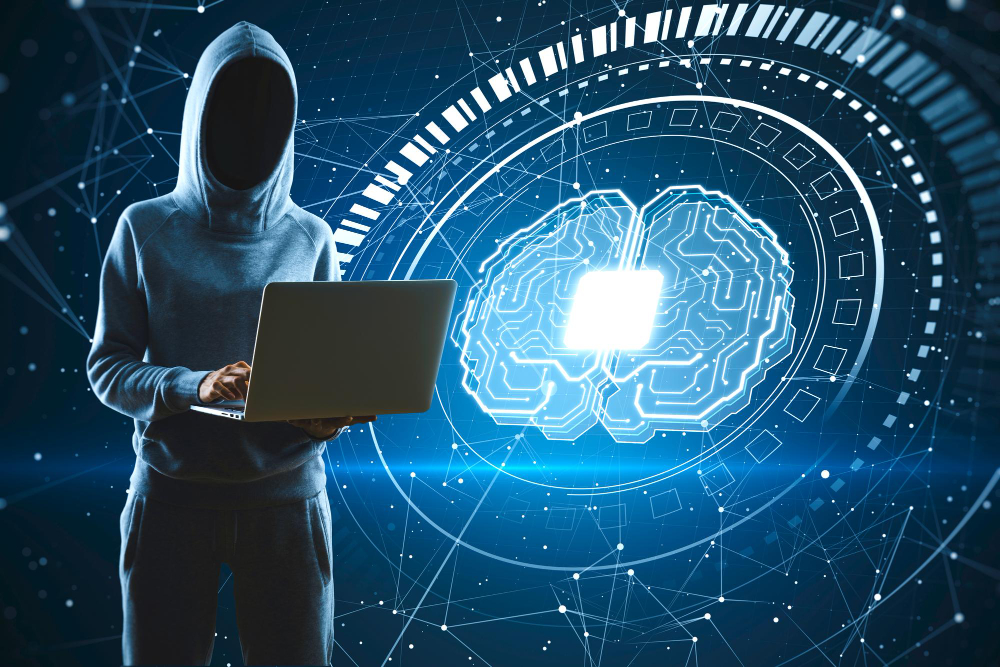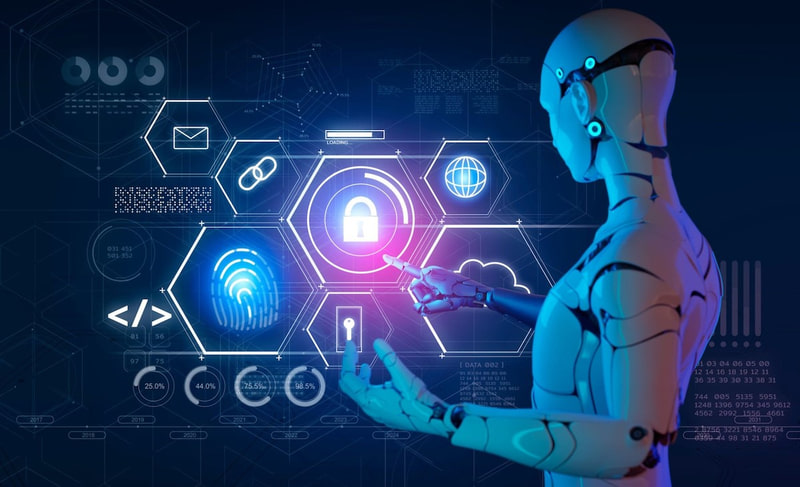The unending cat-and-mouse chase of cyber criminals and cyber security continues, but this time we are dealing with AI-powered cyber attacks. Attacks that once took advantage of known vulnerabilities can now find new ones themselves and adapt automatically.
2023 has been a great year for AI as it has become more accessible for mainstream users. However, with AI becoming more accessible and advanced, it also allowed people with ill intentions to take advantage.
A sudden rise in AI-based attacks was seen when ChatGPT became mainstream, with a 135% increase in AI-based social engineering attacks between January to February of 2023.
As a business owner, this should be a big concern as your current security solutions may not be enough. Your business security, and especially your employees, are extremely vulnerable to sophisticated AI-powered attacks.
In this post, I’ll tell you what are AI-powered cyber attacks and what security measures you can take to protect your business.
AI in the Hands of Cyber Criminals

Malware attacks and other attempts to compromise systems usually depend on specific vulnerabilities or the direct intervention of the hacker. Like social engineering attacks that require a lot of direct interactions and background research on targets to be successful. However, AI makes this process autonomous by doing research on the target and adapting accordingly to attack.
Automation and adaptability are two main reasons AI-based attacks are so dangerous. For example, AI-powered malware can scan the security system’s detection behavior and make changes to its own code to avoid detection. This makes security solutions that depend on predefined rules obsolete.
Furthermore, hackers can perform large-scale sophisticated attacks that have a high rate of success since they are not just some shots in the dark. Each attack is fully capable of analyzing the target and adapting accordingly for the highest success rate.
Not only that, once it gains access, it’s also better at taking advantage of the device, like creating on-spot strategies, generating fake information, disabling security systems, detecting sandbox environments, etc.
Overall, hackers can now launch more sophisticated attacks at a large scale with minimum effort. And it’s not a prediction; some of the attacks have already happened even before AI became mainstream. Let’s see what types of attacks are already at the doorstep:
AI-Powered Cyber Threats

Day by day, new AI attacks are cropping up, and each one is more sophisticated than the last one. Below I am listing some of the AI-powered cyber threats that are already making the news:
#1. AI Spear Phishing Attacks
I am sure you can guess you won’t be getting emails with broken English asking you to click on a phishing link anymore. AI can write error-free convincing emails that can also avoid spam folders to enhance phishing schemes. However, that’s not even the problem, the bigger problem is AI-powered spear phishing attacks.
The spear phishing attack is a type of social engineering attack where personalized communication is used to convince the target to click on a phishing link. However, it’s really difficult to perform manually as the hacker has to first choose the right target and then do a background search on them to start a convincing conversation.
AI makes all this autonomous. Potentially, it can look for vulnerable targets and then run a background search using social media profiles like Facebook, X, LinkedIn, etc to learn more about them. Afterward, engage in a personalized conversation that will look like a human is talking and giving a convincing reason to access the link.
This not only increases the click-through rate but also allows attacks at a large scale with minimum effort. Studies suggest that AI-powered spear phishing attacks can have over 60% higher click-through rates.
Emotet is a good example of malware that used AI to convince users to click on links in emails and even had AI-like functionalities by identifying network infrastructure and creating strategies to spread.
#2. Automated Vulnerability Exploitation

Malware taking advantage of security vulnerabilities is quite common, but usually, the malware is created to exploit specific types of vulnerabilities. Therefore, the chance of the right malware reaching the right vulnerable network/device is quite slim. However, with AI, the malware can scan and look for vulnerabilities in the system to report back or even edit its code to take advantage.
REvil ransomware gang was known to use AI to identify vulnerabilities in systems, and their successful attack on Irish Health Service heavily depended on the use of AI.
#3. Vishing
Generative AI is incredibly good at cloning voices, there are already many voice-cloning tools that let you copy the voice and tone of anyone. Of course, such technology was bound to become part of vishing attacks.
Vishing means voice phishing attacks where the attacker directly calls or leaves a voice message to convince the target to give up information. With AI, the attacker can sound like someone you know to make the attack more convincing:
For example, your company CFO sends an audio message to send money to a specific bank account. The voice and tone exactly match the CFO, and he might say a word or two to make it more personal. I am sure many employees will fall for that, and an AI is easily able to do all that easily.
#4. Deepfake Videos Scam

Similar to voice cloning, deepfake video scams are even worse. Deepfake videos are realistic videos of someone whose videos, images, and voice audio are easily accessible. Hackers can create very convincing deepfake videos and impersonate someone important to take advantage.
Although there have been no headlines of successful deepfake scams targeted toward businesses currently, there have been many media appearances of deepfakes of prominent figures. I am sure many of you will be aware of the deepfake videos of Ukraine and Russian presidents. It shows how easily your company can be a target, too, and it’s anticipated that deepfake scams are the next big cyber security concern.
#5. AI-Powered Botnets
AI can play many useful roles in coordinated botnet attacks like DDoS, credential stuffing, or website scraping. This includes finding vulnerable targets, avoiding detection, constantly shifting C&C servers, and coordinating the overall attack.
The attack on Microsoft Azure is a good example of how AI botnets generated dynamic domains to launch a coordinated attack.
How to Protect Your Business?

Taking note of the above information, you can see there are multiple ways your business is more vulnerable right now. Below is a quick highlight of how it will affect you:
- Automated large-scale attacks: AI allows large-scale attacks with minimum efforts, this means more people and businesses are at risk. This increases your overall risk of being the next target.
- AI is adaptive: AI can adapt to security measures in real time, so your traditional rules and signature-based protection won’t help.
- AI can find vulnerable targets: AI can find vulnerable targets by doing large-scale searches. if your business doesn’t have the latest security solutions, it can become a priority vulnerable target.
- Employees are more vulnerable: Sophisticated AI phishing attacks and deepfake audio/video scams directly exploit human vulnerability; no security system can fix that.
You can guess traditional business security features won’t be enough to protect against these AI-powered cyber attacks. Below are the security measures you can take to enhance your business security.
#1. Use the Right Protection App
You need to fight fire with fire, so for AI-power cyber attacks, you need to get AI-powered cyber security solutions. There are many powerful AI-powered cybersecurity platforms that can protect your business from all ends. Below I am listing the best ones in each category.
- CrowdStrike Falcon: CrowdStrike is known for building its products on AI, and CrowdStrike Falcon is one of the best AI-based endpoint protection tools that actively hunt for threats using behavior detection.
- Darktrace: An all-in-one real-time AI behavior detection system to protect apps, networks, cloud, communication, and much more.
- Recorded Future: It’s a threat intelligence tool that keeps your business up-to-date with the latest threats as they happen.
- VMware NSX: Helps create virtual network micro-segments using AI to prevent the free movement of attackers.
- Okta Adaptive MFA: Okta has an AI-powered multi-factor authentication solution that adapts to user behavior and other circumstances to offer higher login security.
- Zscaler: A zero-trust network access (ZTNA) app that has multiple security solutions to add protection to access to data and network even for authorized users.
#2. Employee Training and Education
Employees are the most vulnerable part of your business. No matter how strong your security system is, if an employee is tricked into giving up access to data; it’s useless. You need to properly educate employees about AI cyber threats, including phishing attempts, social engineering attacks, and deepfakes.
You can also take advantage of cyber security employee training services that cover AI cyber security as well. KnowBe4 is a reliable service for this purpose. They have many courses related to phishing, ransomware, domain spoofing, and other cyber attacks.
I will also recommend you use an anti-phishing tool for employees to detect AI phishing attempts automatically. Vade has a nice AI-based anti-phishing solution that detects AI-powered phishing attacks as well.
#3. Detect Deepfakes

Employee training goes a long way in detecting deepfake attacks. Here’s a nice guide on how to detect deepfakes that will help with that. However, there are also tools that can detect deepfakes automatically. I recommend you give Sensity a try. It can detect deepfakes with reliable accuracy, whether it’s audio, video, or image.
#4. Have an Incident Response Plan
Be proactive, not reactive. Make sure you have a plan to respond to threats as they happen. Some of the tools above, like VMware NSX or CrowdStrike Falcon, can help you minimize the damage once an attack goes into effect.
Your employees should also be educated to act on a plan immediately when a threat is detected. I recommend doing red team exercises to check how good your current security system is and improve security according to the results.
Wrapping Up 🤖⚠️
AI-powered cyber attacks are surely going to increase as they allow large-scale attacks easily. Furthermore, AI development is rapidly improving, which means AI-based attacks are going to get more sophisticated. Honestly, I am more concerned about when AI attacks focus on the Internet of Things (IoT) and cause wide-scale damage.
Along with the above protection measures, make sure you keep up with the latest happenings in the AI cyber security world to adapt to the upcoming threats.


